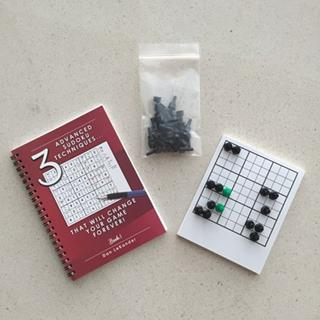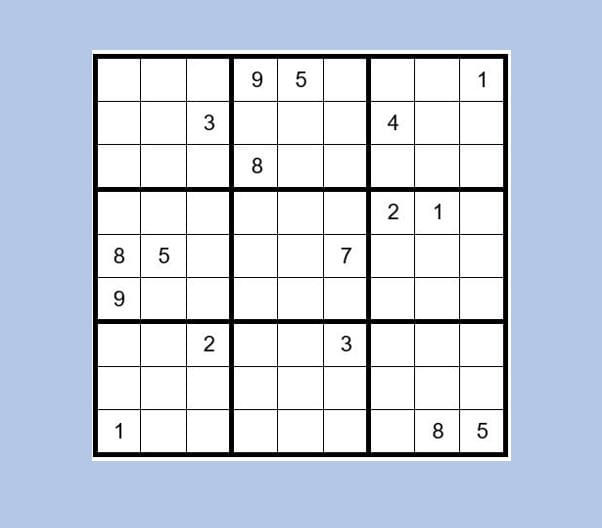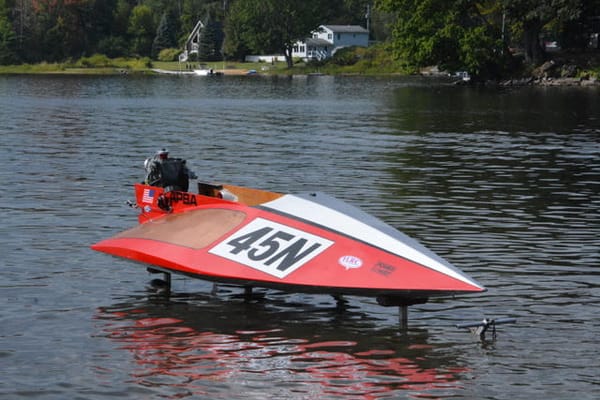Sudoku Puzzle #60 (Yes 60!)
by: Dan LeKander
You may wonder about the puzzle selection for this magazine. Why does the author choose a puzzle each month with 17 given answers? Going back in time I read that valid Sudoku puzzles must have a minimum of 17 given answers, and the maximum is debatable, usually in the 30’s. Additionally, there is belief that no valid Sudoku puzzles can contain only 16 given answers. We say “valid” meaning there can only be one solution for a puzzle. Most likely any puzzle with 16 given answers will have more than one solution.
Ok, so why 17 each month? As you know by now, there is a monthly puzzle which you can solve on your own, or you can follow my lead. Quite simply I seek the most difficult puzzles I can locate. Each morning I solve on the average three 17-given puzzles, looking for the one that can possibly assist you in sharpening your Sudoku skills. Perhaps that is not what you are seeking, but if you learn to solve the puzzles in my articles, you will have the skills to solve any Sudoku puzzle. There is a place at the end of this article to weigh in on your thoughts, should you care to express them.
DAN’S 8-STEP APPROACH TO SOLVING ALL SUDOKU PUZZLES
Once you have completed the puzzle, to the extent that you have filled-in all obvious answers and have written all potential options across the top of the unsolved cells (PUZZLE PREPARATION), Dan recommends the following Steps to complete the puzzle.
Step 1: Sudoku Pairs, Triplets and Quads – See September 2015
Step 2: Turbos & Interaction – See October 2015
Step 3: Sudoku Gordonian Rectangles and Polygons – See November 2015
Step 4: XY-Wings & XYZ Wings – See December 2015
Step 5: X-Wings – See January 2016
Step 6: DAN’S YES/NO CHALLENGE
Step 7: DAN’S CLOSE RELATIONSHIP CHALLENGE
Step 8: AN EXPANSION OF STEP 7
Steps 1-5 are relatively common techniques and are explained in the TI LIFE articles above. Steps 6-8 are covered in detail, in Dan’s book.
If we say 7 saves 6, those of you who have been following my articles will probably realize the meaning!
Puzzle #60 represents a unique experience. It is by far the most difficult puzzle ever presented in my monthly articles (assuming I did not miss a clue)! To solve this puzzle, we will employ a new (to this magazine) technique that rarely needs to be used. More on this technique later in the puzzle.

PUZZLE PREPARATION
Prior to utilizing techniques first complete the 5 Steps of Puzzle Preparation …
1. FILL IN DATA FROM OBSERVATIONS
2. FILL IN OBVIOUS ANSWERS
3. FILL IN NOT-SO-OBVIOUS ANSWERS
4. MARK UNSOLVED CELLS WITH OPTIONS THAT CANNOT EXIST INTHOSE CELLS.
5. FILL IN THE OPTIONS FOR THE UNSOLVED CELLS
This month we will again complete all of the first 4 steps in the order we observe them, versus all step 1, then step 2, step 3, and step 4 in order, before we move on to step 5.
We will start with the 1’s and navigate through 2’s to 9’s, then repeat the process until we conclude all step 1-4 clues. The first thing we observe is that C2R6 (cell in column 2, row 6) =2 (obvious answer). C5R3=3. Now your grid should like Example #60.1 below:

The only cells in box 4 (left-hand middle box of 9 x 9 cells) that can be a 1 are C3R5 & C3R6; therefore, a 1 cannot exist in C3R3. (A 1 cannot exist in C3R1, C3R8 or C3R9, but we already know this). Indicate by placing a small 1 in the bottom of C3R3.
The only cells in box 9 that can be a 2 are C8R8 and C9R8, so put a small 2 in C4R8, C5R8 & C6R8.
The only cells in box 4 that can be a 3 are C1R4 & C2R4, so put a small 3 in the bottom of C4R4 & C9R4.
The only cells in box 2 that can be a 4 are C6R1 & C6R3, so put a small 4 inn the bottom of C6R4, C6R6, C6R8 & C6R9.
The only cells in box 6 that can be a 5 are C7R6 & C8R6, so put a small 5 in the bottom of C4R6 & C6R6.
The only cells in box 2 that can be a 7 are C4R2 & C5R2, so put a small 7 in the bottom of C1R2, C2R2, C8R2 & C9R2.
Now your grid should look like Example #60.2 below:

We have now completed Puzzle Preparation steps 1-4, so we will fill in the options for the unsolved cells. Now your grid should look like Example #60.3 below.

STEPS 1-8
There are no Step 1-5 clues, so we will now proceed to Step 6: Dan’s Yes-No Challenge.
There are 3 circumstances that establish the potential for a Step 6 exercise:
- Look for just 2 unsolved cells in a box that contain the same option where these 2 cells are not in the same row or column.
- Look for just 2 unsolved cells in a column that contain the same option where these 2 cells are not in the same box.
- Look for just 2 unsolved cells in a row that contain the same option where these 2 cells are not in the same box.
We will start by searching the 1’s to see if there is a potential Step 6 clue, and then navigate through the 2-9’s.
There are a number of potential Step 6 clues, but none of them track through the puzzle, such that no unsolved cells are affected by both driver cells. Finally, there is a Step 6 clue with the 8’s. In column 3 we find just two unsolved cells with option 8. We will call these two cells our “driver cells” which drive the exercise. One of these two cells must be an 8. We will first start with C3R1 and assume it is the 8, to see what effect it has on the other unsolved cells with option 8. Then, we will assume C3R8 is the 8, to see what effect it has on the other unsolved cells. We will annotate C3R1 with a “Y” for yes, and annotate C3R8 with “y” to indicate yes. Please refer to Example #60.4 below:

If C3R1=8, then C7R1 not a 8 (marked as “N”) above. Now in box 3, C9R2 must be an 8 (Y). It follows that C9R4 & C9R6=N, C7R6=Y, C5R6 & C6R6=N.
If C3R8=8, then C5R8 & C6R8=n, C5R7=y, and finally C5R6 & C5R4=n.
Our conclusion is simple, C5R6 is not an 8.
Now your grid should look like Example #60.5 below:

In many of the past examples of Step 6 the results led to further clues. In this example we are at an impasse. There are no additional Step 6 clues and no other Step 6 exercises that are successful. Step 7 and 8 rely on at least one 2-digit unsolved cells, and we do not have any of these.
This is the second puzzle in my history that cannot be fully solved with Steps 1-8. Indeed, a rare occurrence!
Nishio is a Japanese word for a technique that can be employed on any Sudoku puzzle. It works like this … pick any unsolved cell and then pick one option for that cell and assume the cells has that number as its solution. Then, track the results through the grid to prove that this cell cannot have the chosen number as its solution, thus eliminating that option.
. You will find the following results:
· The tracking of the number through the grid is inconclusive. You then move on to another choice. This result happens most of the time.
· The tracking of the number through the grid creates a conflict. Then you know that number is not a correct choice for that cell and you eliminate the option. That discovery may or may not lead to additional Step 1-8 clues.
· The tracking of the number through the grid brings you to a successful conclusion. This is a rare occurrence.
The key to this technique is to take some time to pick a cell and option that has a decent chance to track through the puzzle and lead to a conclusion, whether it be a conflict or solves the puzzle. In this particular puzzle I chose C7R1 with the option 8 for the following reasons: there are three numbers that have three given answers, the 1’s, 3’s and 8’s. I had a hunch that starting with C7R1 being an 8 we could possibly track this through the puzzle. We will attempt this in Example #60.6 below:

We will refer to the above example with the tracking. We will use the second level of the unsolved cells to preserve the integrity of the original puzzle. We will track in the order that I see clues (there is no right or wrong way, and there are numerous ways). We see that C2R2=8. C3R8=8. C5R7=8. C8R1=3. C2R3=1. Now note cells C3R1, C3R4, C3R5 & C3R6 form a quad with options 1467, so we can eliminate those digits from any other unsolved cell in column 3. Then C3R9=9, C3R3=5, C3R8=8 & C8R2=5, giving us Example #60.7 below:

Let’s pause a moment to see what we can observe with our track. Note column 2.
You can look at this in two ways. First, there is no possibility of a 9 in column 2, or there are digits 3467 common to 5 cells. Either way, we have achieved an obvious conflict and therefore, C7R1 cannot be an 8. Since there are only two unsolved cells in box 3 that can be an 8, we now know that C9R2=8. Go back to the original puzzle, Example #60.8 below.

We see above that C7R6=8, C7R3=5 (only unsolved cell left in column 7 that can be a 5). C1R2=5 and so forth, leading to an easy solution, Example #60.9 below:

You may employ the Nishio technique on any puzzle at any point if you please, as it can produce interesting results.
I hope you have enjoyed this Sudoku article this month, as I have enjoyed writing it.
May the gentle winds of Sudoku be at your back.
Dan LeKander
Editor's Note: It was back in January 2016, when we published a final article in Dan's series of steps to learn the logic of Sudoku – when he asked if we would like a puzzle to solve every month … this editor said an enthusiastic… Yes, please! Now we are several years later and on Puzzle #59. (How many have you solved... please let us know!)
If you have not already done so, I suggest you purchase Dan’s book: “3 Advanced Sudoku Techniques, That Will Change Your Game Forever!” Purchase of a book includes a 50-page blank grid pad, 33 black and two green tokens, to assist with Step 6.…

The book is available online at ebay.com.
Most importantly, I ask that you leave comments on any part of his series and throughout the year.
And now we are in October 2019... many puzzles later... I want to thank Dan…and his proofreader… Peggy! I am hoping you will enjoy our monthly Sudoku and at the same time join me in saluting Dan - Bravo to you both…(As I said last month - mind you sometimes I am not so polite when I can't solve the puzzle...)
Be sure to read the review of Dan's book by Jesse Kahn published in Jun 2015.
Also all past Sudoku Puzzle Challenge beginning: February 2016, March 2016, April 2016, May 2016, June 2016, July 2016, August 2016, September 2016, October 2016, November 2016, December 2016, January 2017, February 2017, March 2017 , April 2017, May 2017, June 2017, July 2017, August 2017, September 2017, October 2017, November 2017, December 2017, January 2018, February 2018, March 2018, April 2018. May 2018, June 2018, July 2018, August 2018, September 2018 , October 2018, November 2018, December 2018, January 2019, February 2019, March 2019, April 2019, May 2019 June 2019, July 2019, August, 2019, September 2019 and October 2019.






Please click here if you are unable to post your comment.